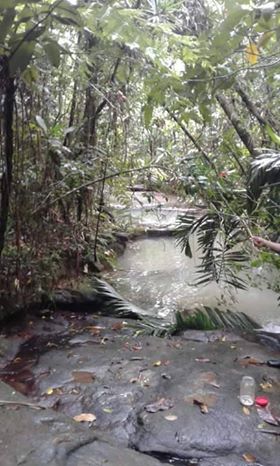Relocation of the Ruby Rose Hibiscus
Date: April 27th – May 10th, 2019
Village: Naduru, Dogotuki, Macuata
Search Team: Aminisitai Degei, Viliame Vuinabuna, Vilise Rokouga, Paula Wasasala
Author: Rosemary Dautei | rosedautei@gmail.com
The Story of the Relocation of the Ruby Rose Hibiscus (Hibiscus macverryi) in Naduru, Macuata, Fiji
Naduru village, my village, is situated in a semi coastal area in the district of Dogotuki, Macuata province, Fiji. On April 27th, 2019 I read about an ongoing search by Savurua Botanical Gardens for the Ruby Rose Hibiscus. In 1923 this hibiscus had been found growing wild in Macuata by William Greenwood (who was at the time working with the Colonial Sugar Refinery). Greenwood’s botanical specimen is lodged in the Kew Herbarium in the UK. On the herbarium label it records that the Ruby Rose hibiscus was growing next to a creek in shaded forest in mountains near the coast (at an elevation of around 600 ft or 200 m).

Ruby Rose Hibiscus, as observed in Navula, Dawamona, Naduru on May 10th, 2019 (Photo: Vilise Rokouga)
The finder of Ruby Rose hibiscus in wild was to be offered a reward as part of a Stanley Smith Grant to Botanical Gardens Conservation International and its local partners, Savurua Botanical Gardens and NatureFiji-MareqetiViti.
(Ta Levu-Uncle) Aminisitai Degei upon receiving the news agreed to aid in the search for a botanical flower documented in the province almost a century ago and he was very excited. Having seen the plant within the village vicinity daily, Ta Levu was sure the task was going to be a smooth sail. The search team initially consisted of a team of three –Ta Levu and his two sons Vili and Vilise. A field plan were clearly laid out using their trusted traditional ecological knowledge and the trusted visual mapping skills. It was calculated that it might take two days (maximum) to rediscover the hibiscus in the wild.
Designated search sites were the nearby bushes, old village sites and two sites further into the forest…..where they would have encountered the “oh I know exactly where that is” plant/flower during one of their constant food hunt to the vegetable and root crop farms or during a wild pig hunting trip. Remember the timeframe was going to be a day or two. So the search began….Sunday and food preparation time excluded… without taking into account the unforeseen village obligations. Monday came, then Tuesday –the village is hosting a religious meeting, a fishing trip, a funeral then…..

Vu ni Aute at Navula creek (Photo: Vilise Rokouga)
Talanoa (village consultations and discussion), is the most successful form of getting things done in Fiji villages from time immemorial, including Naduru. But five days had passed. The search leader, 72, as good as an aged wine had combed the nearby area (only to find a non-flowering hibiscus probably Ruby Rose) and was going to hunt the forest. He went as far as Wailevu- a common freshwater fishing ground for prawns and other freshwater species for villagers. Wailevu creek is the main water body where other creeks branch off, including Navula creek. Ta Levu knew he had spotted it there, and also recalls there is a spot named Vu ni Aute (Figure 4). ‘Aute is hibiscus in Dogotuki dialect (and throughout Polynesia) and Vu ni means plant of)……time caught up and the root crops he had collected earlier had to be taken to the village to be prepared for a day’s meal. He would return.
Like father, son Vilise is an avid roamer of the forest. Kaulise (as I call my cousin) is always excited about conservation – whether it’s marine or terrestrial. He was aware of the remaining search site and was taking pictures of the many hibiscus within the village, for comparison.

Paula Wasasala identifying the species of interest. (Photo: Waisea Brown)
One of our dear grandmothers, who had returned the previous day after visiting her sister, relayed to Vilise how a similar exercise was being carried out in that community, Vunivesi, where Ruby Rose Hibiscus was also growing. Her older sister also informed her of having transplanted the species from Wailevu creek or nearby area where they once lived while farming. She also mentioned a place named ‘Vu ni Aute’ in Wailevu as reference to the spot where a hibiscus plant is. A cutting was also planted in Naduru then.
Vilise joined the dots and notified Paula Wasasala of the nearby Valeto’oni village, whose farm is in Wailevu/Navula area. Vilise had asked Paula to photograph the hibiscus he observes along the way.
May 9th 2019…it’s been twelve days of searching!!!! Yes, in my village that’s how a proposed two days’ timeframe for a ‘very common’ flower search could take. Paula stumbled into the plant on his way to the farm and took pictures (Figure 5). Upon sending the pictures to Dr Lex Thomson (Savurua Botanical Gardens), it was confirmed as the species of interest, The Ruby Rose. I relayed the news back to the hardworking team, with much excitement from all parties.

Vilise Rokouga at Navula to collect a cutting of the hibiscus. (Photo: Waisea Brown)
A cutting has been planted in the village (Figure 6), as requested by Savurua Botanical Gardens Fiji.
In conclusion, successful village tasks are always a communal effort. Excitement is in the air to be part of a successful rediscovery of Ruby Rose Hibiscus!
Note: Navula is a creek that flows through the Dawamona clan land. Names of areas in this land is commonly referred via the creeks or river than the land name. Dawamona is one of the clan that makes up Naduru tribe. Valeto’oni is a community adjacent to Naduru village and is also known as Naduru-i-ca’e (Map 1). Hence Ruby Rose Hibiscus was found in Navula on Dawamona land in Naduru, Dogotuki, Macuata.

Ruby Rose Hibiscus cutting planted in Naduru Village. (Photo: Vilise Rokouga)



